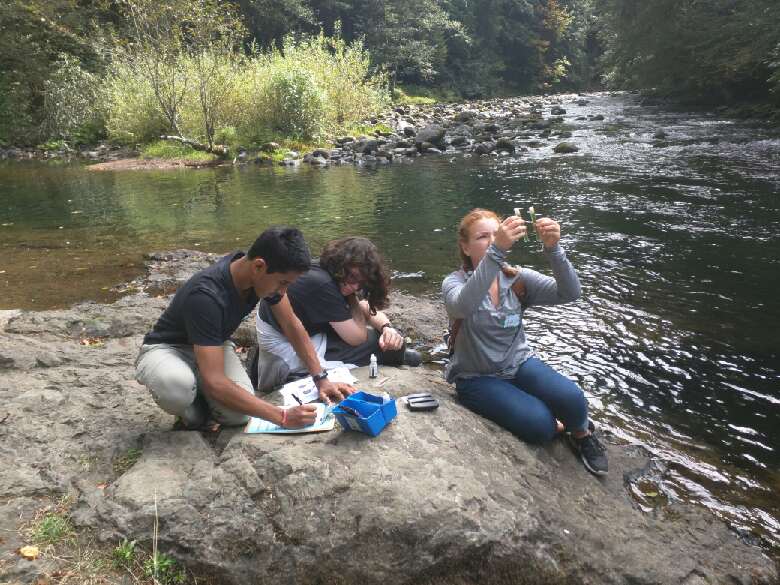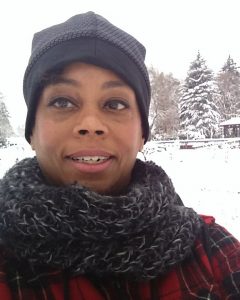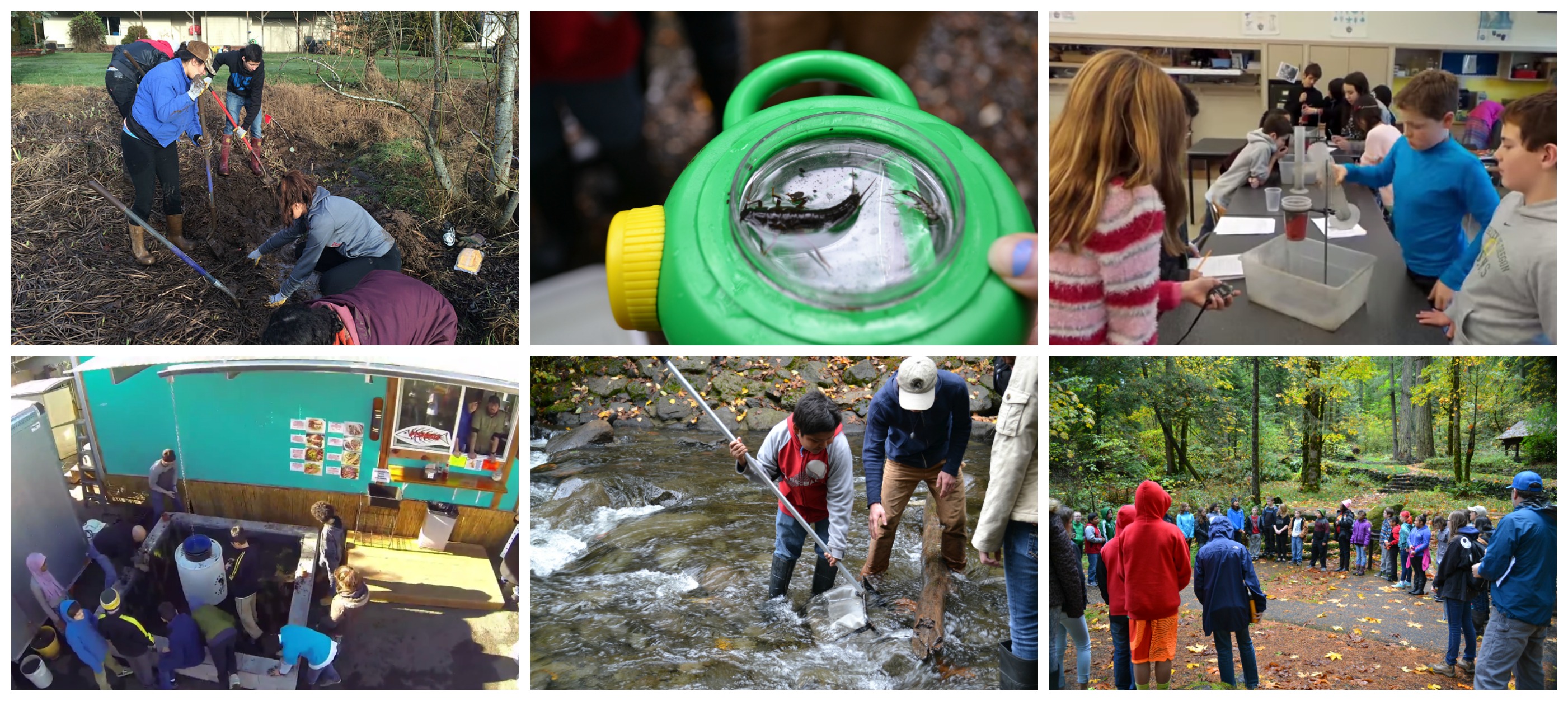Issues related to ecology, watershed health and salmon don’t just belong in a biology or environmental studies class. They are pertinent to a wide variety of subjects, and connect many themes throughout science, social studies, history, and language arts.
That’s why 7-8 grade science teacher Alfonso Garcia Arriola and 7-8 grade social studies and language arts teacher Heather Kelly-Siegfried at ACCESS Academy make such a wonderful interdisciplinary teaching team!
Alfonso Garcia Arriola has been a science educator for 19 years, including 14 years at ACCESS Academy. In 2016, he was honored with the NSTA’s Robert E. Yager Excellence in Teaching Award. Heather Kelly-Siegfried has been teaching middle school language arts and social studies for 16 years, including 4 years at ACCESS Academy.
Click on the title to read more!
ACCESS Academy, located in Northeast Portland, provides an alternative rigorous academic program for students in grades 1-8. ACCESS strives to cultivate a learning environment where highly gifted students whose educational needs are not being met in the general education setting can thrive socially, emotionally, and academically. The school promotes self-directed learning, character development, and community service.
The following is an interview in which Alfonso and Heather explain why they love working with Salmon Watch, and why it’s so important to help students make connections to ecology and the environment across disciplines.
Why is outdoor environmental education important?
ALFONSO: Outdoor environmental education allows students to experience what conducting science in the real world is like. It gives them an opportunity to connect what happens in the classroom to the real world, which makes their in-class lessons much more relevant. Making lessons relevant is crucial for getting students engaged, and that’s a big part of what outdoor environmental education provides. It allows students to see the real world application.
HEATHER: For me, a big part of what makes outdoor and place-based education so important is its social and cultural significance. Students get a chance to realize how they are connected to nature, and environmental education helps them see that they have a stake in protecting their environment.
What’s your favorite part of working with Salmon Watch?
HEATHER: What really stuck with me from my Salmon Watch field trip experience was the way I saw my students working together. Students were helping each other during the field experience, and they were really engaged. I noticed that they were really respectful of each other, respectful of the volunteers, and also respectful of the environment. Those things really stood out to me as some of the positive outcomes from the Salmon Watch program.
ALFONSO: One of the other positive outcomes I recognize has to do with the purpose of education. Plato argued that education is not just the accumulation of correct beliefs; it is having adequate reasons for these beliefs. The Salmon Watch experience provides students the opportunity to engage with the curriculum rather than just learning a series of facts.
How did you incorporate Salmon Watch into your in-class lessons?
ALFONSO: In my science class, instead of starting with cells and molecules, I decided to begin the curriculum with ecology so I could more easily integrate salmon and issues of ecology around salmon. Typically, ecology is not taught until later in the year. But I was able to give the students a sense of the importance of ecology at the beginning of the year and to teach about ecology through the point of view of the salmon life cycle.
HEATHER: I incorporated Salmon Watch and environmental education into my lessons in a different way, of course, because I’m teaching language arts and social studies with a focus on US history. I started this year with the geography of pre-Columbian America. We discussed the tribes of the Pacific Northwest and their connection with salmon and the Columbia River. I had my students read traditional stories from the tribes of the Pacific Northwest and then re-enact them.
That experience helped them see how salmon are interwoven with tribal life and culture. And we learned about the significance of salmon in post-Columbian America and the significance of salmon and the Columbia River to the students’ lives.
How did you work together as an interdisciplinary team?
HEATHER: This is my first time being involved with Salmon Watch, and Alfonso has done it several times. I usually don’t get the chance to collaborate with anyone outside of the language arts and social studies disciplines. Salmon Watch gave me the opportunity to work with Alfonso, and I really enjoyed getting to discuss with him how I was planning to incorporate the Salmon Watch material in my room, and how he was doing it in his room. It really helped me with teaching the past and present, and the connections that relate to cultural and environmental history. It was really valuable for me to have the opportunity to work with a teacher from another discipline.
ALFONSO: In years past, as a science teacher, I’ve struggled to cover the aspects of the curriculum that deal with language arts and stories. I focused heavily on the science content in the curriculum when I participated in Salmon Watch by myself. And this year, having Heather participate was great because the students could look at the issue of salmon in different classes. When they left the science class, and they understood the science components and the ecological components of the curriculum, then they could continue with the topic and explore it from the language arts and social studies perspectives.
What else stands out for you that you’d like to add?
ALFONSO: I really appreciate the Salmon Watch volunteer educators. It’s the volunteers that make it such a great experience for the students. Students might get a chance to work with someone who has spent a lifetime working on water quality issues or salmon biology. Salmon Watch works with volunteers who are retired from public agencies such as the US Forest Service and the US Department of Fish and Wildlife, for example.
For them to share their experiences with students, and for students to be able to interact with someone who is not a teacher but has a huge connection to education through involvement with young students, that’s a major benefit I see of the Salmon Watch experience for students.
HEATHER: As Alfonso just said, a great part of the experience was that my students got a chance to interact with people who are not their normal teachers; they’re people in the community who’ve been working in their fields for most of their lives. The students were exposed to careers that hopefully some of them will want to pursue. Hopefully they’ll want to work for US Fish and Wildlife, and they’ll want to continue the work of keeping Pacific Northwest rivers a healthy place for salmon and other fish and wildlife.






Recent Comments